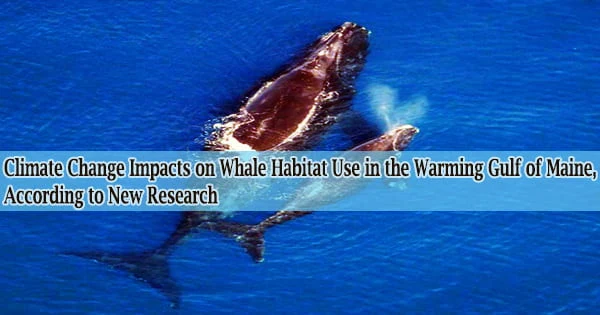Right whales’ use of Cape Cod Bay has changed dramatically over the past 20 years, according to new research that shows climate change is having an impact on how large whale species, including the critically endangered North Atlantic right whale, use their habitats in the warming Gulf of Maine.
Researchers from the University of Massachusetts Amherst, the USGS Northeast Climate Adaptation Science Center, the Center for Coastal Studies, UCLA, the National Marine Fisheries Service, and the Canadian Whale Institute participated in the study, which was led by the New England Aquarium and published this month in the journal Global Change Biology.
The authors’ goal was to gain a better understanding of how phenology the timing of cyclical biological phenomena like plant flowering is affected by changes in ocean climate. The researchers examined patterns in peak use for North Atlantic right whales, humpback whales, and fin whales using data spanning more than 20 years to determine changes in whale habitat use in Cape Cod Bay.
According to the study, humpback and right whales now use Cape Cod Bay at its busiest roughly three weeks later. When spring officially begins has been shifting as a result of climate change, which has an impact on whale habitat utilization.
The study found that right whales used their habitat more frequently in Cape Cod Bay from February to May, with the biggest increases occurring in April and May, indicating that highly migratory marine mammals can and do adapt the timing of their habitat use in response to climate-driven changes in their environment.
“The time of year when we are most likely to see right and humpback whales in Cape Cod Bay has changed considerably, and right whales are using the habitat much more heavily than they did 20 years ago,” said lead author Dr. Dan Pendleton, Research Scientist in the New England Aquarium’s Anderson Cabot Center for Ocean Life.
The research team obtained information from aircraft surveys carried out by the Center for Coastal Studies between 1998 and 2018 and examined environmental information including sea surface temperatures and the dates that denote the beginning of spring each year.
One of the biggest gaps in our understanding of how climate change is shifting the yearly cycles of life in the oceans involves the largest migrating animals whales. Even though they’re the largest mammals on earth, we have an incomplete understanding of where some whales go and when. This new research helps us understand how seasonal whale migration is changing, which is critical for their protection and conservation in our region.
Michelle Staudinger
The researchers studied variations in whale habitat utilization over time using an unique statistical method, which shed light on the long-term consequences of climate change on whale habitat.
In order to examine phenological and biological reactions to climate change, such as animal migrations, productivity peaks, and breeding, scientists chose the Gulf of Maine, one of the ocean basins that is warming up one of the fastest.
In recent decades, the Gulf of Maine’s sea surface and bottom temperatures have risen three times faster than the global average. The Gulf of Maine’s whale population has changed due to changes in ocean circulation and temperature, including early spring, later fall, longer summers, and shorter winters.
“One of the biggest gaps in our understanding of how climate change is shifting the yearly cycles of life in the oceans involves the largest migrating animals whales,” said Michelle Staudinger, an ecologist with the U.S. Geological Survey, science coordinator at the Northeast Climate Adaption Science Center and professor of environmental conservation at UMass Amherst.
“Even though they’re the largest mammals on earth, we have an incomplete understanding of where some whales go and when. This new research helps us understand how seasonal whale migration is changing, which is critical for their protection and conservation in our region.”
The authors also proposed that right whales might be utilizing Cape Cod Bay for a longer period of time since other areas in the Gulf of Maine no longer provide as much food due to climate change. Right whales may now use the bay as a sort of “waiting room” as stronger prey resources emerge in new environments, such the Gulf of St. Lawrence, as a result of these changes.
There are just 336 North Atlantic right whales left, making them a critically endangered species. The population of whales has decreased over the past ten years as a result of human activities such vessel hits and entanglements in fishing gear.
The presence of huge whales in Cape Cod Bay raises serious concerns because fishermen and ship owners depend substantially on the area. The historical peak in North Atlantic right whale habitat utilization was planned to coincide with vessel speed limits and fishing bans in Cape Cod Bay.
The study shows that, as threatened and endangered whales adjust to their feeding and migratory patterns in response to climate change, government authorities must continue to change protective measures for these species.
“Changes in whenwhales use their traditional habitats has important implications for the design of protected areas. This issue is especially important as climate change continues to alter animal migrations,” Pendleton said.





